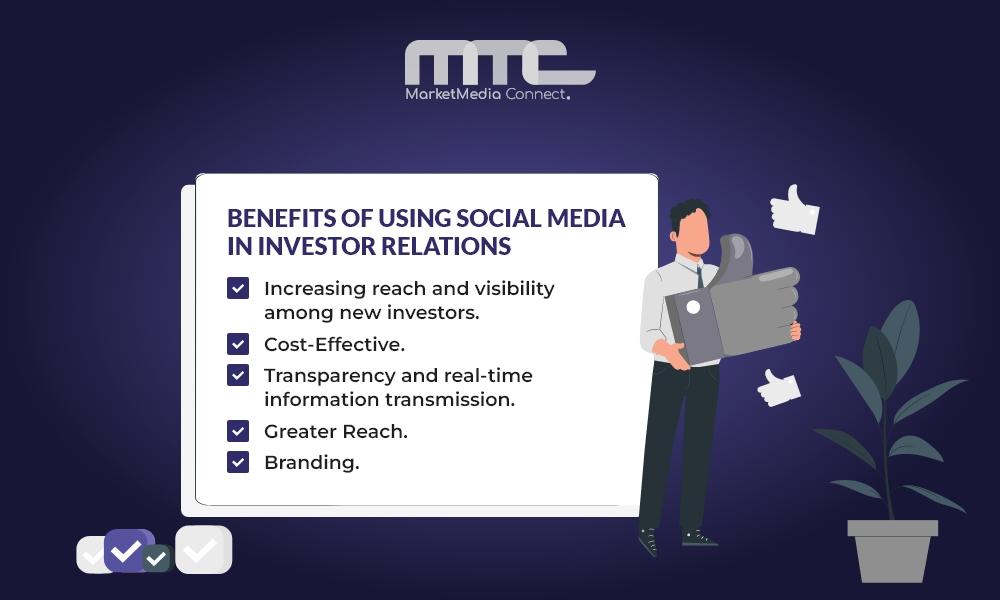Content
Harnessing the Power of Social Media in Investor Relations
Conventional modes of communication have experienced a drastic shift in today’s digitally connected world. Investor relations has traditionally focused on formal communications like press releases, and annual reports. However, the rise of social media platforms has resulted in a seismic shift in how corporations communicate with their investors in the digital age. Without Social Media in investor relations, your plan is hollow, and no strategy will bring your company investors.
With millions of people constantly engaged on various social media channels, businesses have to capitalize on the potential of these platforms to improve their investor relations efforts. This blog will discuss the critical role that social media plays in investor relations, emphasizing its benefits, successful techniques, and the development of trust and credibility. It will also discuss the obstacles and dangers of social media IR, as well as give insights into gauging performance through important metrics and analytics. By the conclusion, you will have a thorough grasp of how to use social media successfully in investor relations for optimal communication, engagement, and achievement of corporate goals.
The Changing Landscape of Investor Communications
Traditionally, investor relations relied heavily on one-on-one meetings, voluminous yearly reports, and painstakingly produced press releases. Yet, in today’s digital age, a 280-character tweet can send stocks flying or tumbling; a LinkedIn post can attract hordes of potential investors; and a well-produced YouTube video can clearly communicate complex financial statistics.
What is driving this shift? The answer is a combination of innovative digital technology and shifting demographics of people wielding its power. The millennial and Gen Z populations, who are digital natives who expect immediacy, transparency, and relevance, have emerged as key actors in the investing scene. People don’t have time to read your annual reports in today’s fast-paced environment; they want quick but effective info, which may be obtained by leveraging digital marketing for investor relations.
Benefits of Using Social Media in Investor Relations

Investor relations social media is now the backbone of every business, as evidenced by the fact that 75% of investors now utilize social media to guide investment decisions, according to recent research. There are several advantages to using social media in investor relations, some of which are listed below:
#1. Increasing reach and visibility among new investors
Do you want to attract new investors? The solution is social media. You can expand your reach beyond traditional channels by proactively marketing your firm and its investment prospects on platforms where investors congregate. It’s the difference between whispering your investment pitch down a dark alley and shouting it from the rooftops. Rooftops, perhaps, but you get the point.
#2. Cost-Effective
The broad reach of a viral tweet or a fascinating LinkedIn post may frequently outperform that of expensive investor conferences at a fraction of the expense.
#3. Transparency and real-time information transmission
Timing is key in the area of investor relations. Social media lets you rapidly communicate crucial updates, financial results, and other facts with investors. No more anticipating the yearly report as if it were a long-awaited episode of your favorite television program.
#4. Greater Reach
Because social media is international, regional barriers are no longer an issue. A startup in Berlin may now easily connect with investors from Tokyo to San Francisco.
#5. Branding
Today’s investors look beyond numbers. Social media provides a window into a company’s ethos, beliefs, and culture, allowing for deeper interactions.
Top Social Media Platforms for Investor Relations
Companies must commit resources to the creation of digital marketing strategies for investor relations, leveraging the use of social media platforms for their vast reach and rising impact with investors, in order to remain competitive.
Because of the multitude of channels accessible today, businesses can alter their strategy based on their audience and message:
- Twitter (X): With its rapid-fire pace, it’s perfect for announcements, financial updates, and direct stakeholder engagement.
- LinkedIn: The premier B2B platform offers a space for in-depth analyses, whitepapers, and professional networking.
- Facebook & Instagram: Through immersive stories and visuals, companies can pull back the curtain, giving a more human touch to the often sterile world of finance.
- YouTube: With video consumption on the rise, businesses can present interviews, in-depth analyses, and more in an engaging format.
- Reddit: It is a community-based website that lets you view news and what others are talking about. Additionally, you may participate in open debates about your area of interest and get solutions from specialized groups or subreddits.
- Clubhouse and other platforms: Real-time voice discussions allow for immediate feedback, debates, and deep dives into financial topics.
Overcoming Challenges and Risks in Social Media Investor Relations
While the benefits are substantial, social media engagement can also attract negative feedback or misinformation.
#1. Managing regulatory compliance on social media platforms
Navigating the regulatory landscape while harnessing the power of social media can be tricky. Ensure that your social media efforts comply with relevant laws and regulations, such as disclosing material information and avoiding misleading statements. Establish clear guidelines and implement thorough monitoring systems to stay on top of compliance issues.
#2. Mitigating potential reputational risks and crises
Social media is a double-edged sword. While it presents an opportunity to build trust, it also exposes your company to reputational risks. Develop a crisis management plan that includes monitoring social media conversations, addressing negative sentiment promptly, and having a clear escalation process for handling potential crises. Being proactive and transparent in managing these risks will help protect your company’s reputation.
#3. Handling social media trolls and negative sentiment
No matter how excellent your social media strategy is, you may encounter trolls or negative sentiments. It’s important not to take it personally and to respond in a professional manner. Avoid engaging in heated debates but instead, focus on providing accurate information and addressing valid concerns. Sometimes, a lighthearted and witty response can defuse the situation and win over even the harshest critics.
Best Practices for Implementing Social Media in Investor Relations
Harnessing the full potential of social media for IR requires a strategic approach:
- Consistency: Regular, meaningful communication fosters trust. It’s crucial to maintain an active presence without overwhelming your audience.
- Authenticity: Authentic, transparent communication distinguishes genuine businesses from the rest in a sea of online information.
- Monitoring & Feedback: Modern platforms offer a trove of analytics. By understanding engagement metrics and sentiment, strategies can be continually refined.
- Legal Considerations: While social media offers flexibility, it’s essential to remain compliant with regulations, ensuring that all disclosures are accurate and timely.
Measuring Success: Key Metrics and Analytics for Social Media Investor Relations

It is critical to assess the results of your digital marketing strategy in Investor Relations since it will show you how your strategy performs and allow you to make necessary changes over time by removing strategies that are not performing and trying new techniques.
Relevant Metrics in Social Media IR:
- Track engagement rate to measure content effectiveness.
- Monitor follower growth for audience expansion insights.
- Measure reach to gauge content spread.
- Utilize sentiment analysis for investor feedback.
Data Analysis and Strategy Refinement:
- Deep dive into analytics to understand content resonance.
- Identify top-performing platforms for resource allocation.
- Use insights for content strategy refinement.
- Optimize approach for maximum ROI.
Benchmarking against Industry Peers:
- Analyze competitor strategies for industry best practices.
- Compare engagement levels to identify content gaps.
- Monitor follower growth rates of peers.
- Set realistic goals to outperform in the investor relations landscape.
Final Thoughts
In today’s investor relations, social media is a crucial instrument. Social media is continuously changing, with new platforms and trends appearing all the time. To guarantee that your investor relations initiatives continue to be successful, stay up to date on the most recent social media developments. Investigate new platforms, test out upcoming trends, and modify your content to suit shifting consumer tastes. You can keep a competitive edge in the social media environment by staying on top of trends.
Companies can fully utilize social media for investor relations and prepare the road for long-term success in the constantly changing digital world by implementing the appropriate tactics and monitoring progress through important metrics and analytics.










